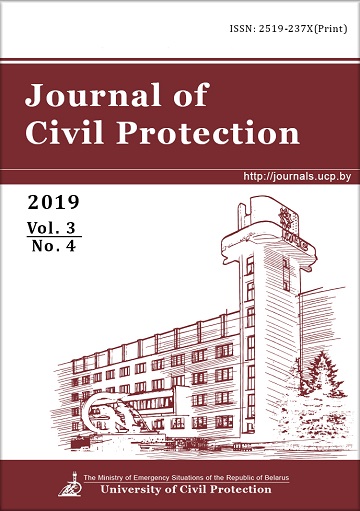Calculation of the protection of a thermal thin body protected by an absorbent coating
DOI:
https://doi.org/10.33408/2519-237X.2019.3-4.400Keywords:
thermally thin body, heat-absorbing coating, non-stationary thermal conductivity, fire resistance limitAbstract
Purpose. The protection of a flat thermally thin body from the heat effect of a fire is considered. Protection is carried out using a flat uniform layer of inert heat absorbing material applied to the body surface. The aim of the work is to find the dependence of the temperature of the protected body on the time of exposure.
Methods. The problem is reduced to a linear task of unsteady heat conduction with boundary conditions of the third kind at the external boundaries of the system. The solution was performed using the Laplace transform of time variable.
Findings. For the first time, an analytical solution of this problem under stationary boundary conditions of the third kind was obtained. It is presented in a dimensionless (criterial) form, as the dependence of the relative excess temperature of a thermally thin body on five criteria: 1) the Fourier criterion of the problem of heating the heat-shielding layer; 2) two criteria of Bio; 3) the ratio of the surface heat capacities of the coating and the thermally thin body; 4) relative excess temperature of the medium on the unheated side. The temperature dependence of a thermally thin body on time has the form of an infinite series, the terms of which exponentially decrease with increasing time. An explicit form of the dependence of the terms of the series on the parameters of the problem is obtained. The explicit form of the characteristic equation of the problem and the intervals of uniqueness of the roots of this equation are indicated, which greatly simplifies obtaining the numerical value of these roots. It is shown that for most temperature calculations the first two terms of the corresponding series are sufficient.
Application field of research. Based on the obtained relations, formulas for the explicit functional dependence of the fire resistance on the parameters of the thermally thin body and the protective coating are written. The results obtained allow calculating the fire resistance limit of metal structures with protection. The introduction of the reduced thickness of structures instead of the thickness make it possible to apply the relations to the metal structures of non-flat section.
References
Golovanov V.I., Pavlov V.V., Pekhotikov A.V. Ognezashchita stal'nykh konstruktsiy plitnym materialom PYRO-SAFE AESTUVER T [Fire protection of steel structures with slab material PYRO-SAFE AESTUVER T]. Fire and Explosion Safety, 2016. No. 25 (11). Pp. 8–16. (rus) DOI: 10.18322/PVB.2016.25.11.8-16.
Golikov A.D., Cherkasov E.Y., Danilov A.I., Sivakov I.A. Sposob ognezashchity obdelki transportnykh tonneley iz chugunnykh tyubingov [Method fire protection of cast iron tunnel lining]. Fire and Explosion Safety, 2016. No. 25 (12). Pp. 22–29. (rus) DOI: 10.18322/PVB.2016.25.12.22-29.
Lykov A.V. Teoriya teploprovodnosti [Theory of heat conduction]. Moscow: Vysshaya Shkola, 1967. 600 p. (rus)
Sharshanov A.Ya. O kriteriyakh pozharnoy bezopasnosti [On the criteria for fire safety]. Problemy pozharnoy bezopasnosti, 2018. No. 37. Pp. 166–172. (rus)
Published
How to Cite
License
Copyright (c) 2019 Sharshanov A.Ya.
CC «Attribution-NonCommercial» («Атрибуция — Некоммерческое использование») 4.0




















